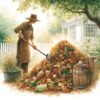Best herbs for an indoor herb garden
Introduction
Embarking on the journey of indoor herb gardening is both rewarding and delightful. This comprehensive guide is designed to help you every step of the way, from planning to harvesting. Whether you’re a culinary enthusiast eager to add fresh herbs to your dishes or someone looking to bring more greenery into your home, this guide will provide you with all the information you need to create and maintain a thriving indoor herb garden.
Planning Your Herb Garden – Laying the Foundations
The first step in your herb gardening adventure is planning. Proper planning ensures that your herb garden is set up for success from the very beginning. This stage involves selecting herbs that are well-suited for indoor growth, finding the ideal location in your home, and gathering all the necessary supplies. By choosing the right herbs and ensuring they have the perfect environment to thrive, you’re laying a strong foundation for your indoor garden.
- Selecting Your Herbs
- Opt for herbs that are known for their ability to thrive indoors, like basil, mint, parsley, cilantro, chives, and thyme.
- Consider what herbs you frequently use in your cooking to make your garden both practical and enjoyable.
- Finding the Perfect Spot
- Choose a location that gets at least six hours of sunlight daily; south-facing windows are typically ideal.
- If natural light is limited, consider using grow lights to supplement.
- Gathering Supplies
- Prepare with pots that have drainage holes and accompanying saucers.
- Get a high-quality potting mix that’s suitable for indoor plants.
Step by Step Creation Guide – Planting Your Herbs
After planning, the next exciting phase is planting. This step-by-step guide will walk you through preparing your pots, planting your herbs, and setting them up for initial growth. This process is straightforward and immensely satisfying as you begin to see your herb garden take shape.
- Preparing Your Pots
- Fill each pot with potting mix, leaving about an inch of space at the top for watering.
- Planting
- Plant your seeds or seedlings as per the instructions on their packets.
- Ensure adequate space between herbs to avoid overcrowding.
- Initial Watering
- Water your herbs thoroughly after planting, ensuring the soil is moist but not soaked.
- Providing Light
- Position your pots in your pre-selected sunny location or under grow lights.
Managing Your Herb Garden – Ongoing Care
Now that your herbs are planted, the focus shifts to maintenance. Managing your herb garden involves regular watering, fertilizing, pruning, and keeping an eye out for pests and diseases. This section provides tips on how to care for your herbs, helping them grow healthy and strong.
- Watering
- Regularly check the soil’s moisture and water when the top inch feels dry.
- Be mindful of over-watering to prevent root rot.
- Fertilizing
- Apply a balanced, water-soluble fertilizer once a month during the growing season.
- Pruning
- Trim the tips of your herbs regularly to promote bushy growth and prevent them from becoming leggy.
- Remove any leaves that are yellowing or dead.
- Pest and Disease Management
- Regularly inspect your plants for any signs of pests.
- Employ natural remedies, such as neem oil, for safe and effective treatment.
Ensuring Long-Term Growth – Sustaining Your Garden
To keep your herb garden flourishing over the long term, you’ll need to implement certain practices. This involves repotting herbs as they grow, adjusting care routines with the changing seasons, and understanding the best ways to harvest your herbs. These strategies ensure that your garden remains productive and a constant source of fresh flavors.
- Repotting
- Move herbs to larger containers if they outgrow their initial pots or become root-bound.
- Seasonal Adjustments
- Adjust your watering and lighting routines to accommodate seasonal changes in light and temperature.
- Harvesting
- Regularly harvesting your herbs not only provides you with fresh flavors for your cooking but also encourages new growth.
Conclusion
Starting an indoor herb garden is a fulfilling way to bring fresh flavors and greenery into your home. By following these step-by-step instructions, you’ll be well on your way to enjoying the myriad benefits of your own herb garden. Happy gardening!










